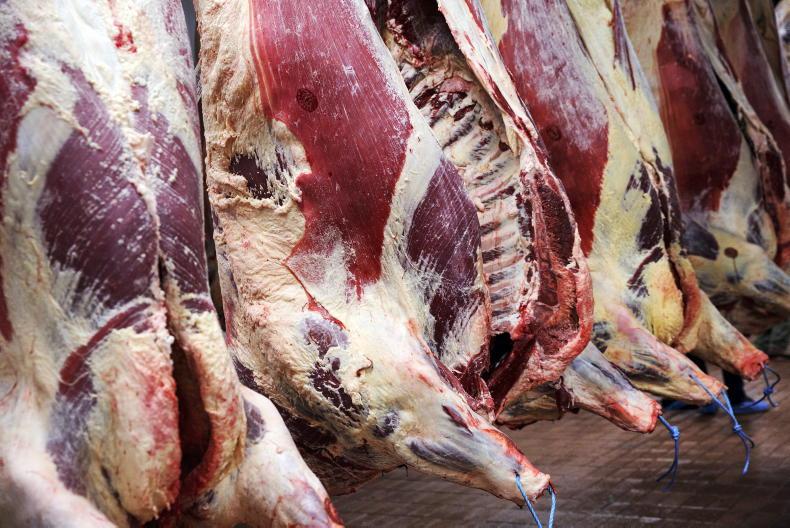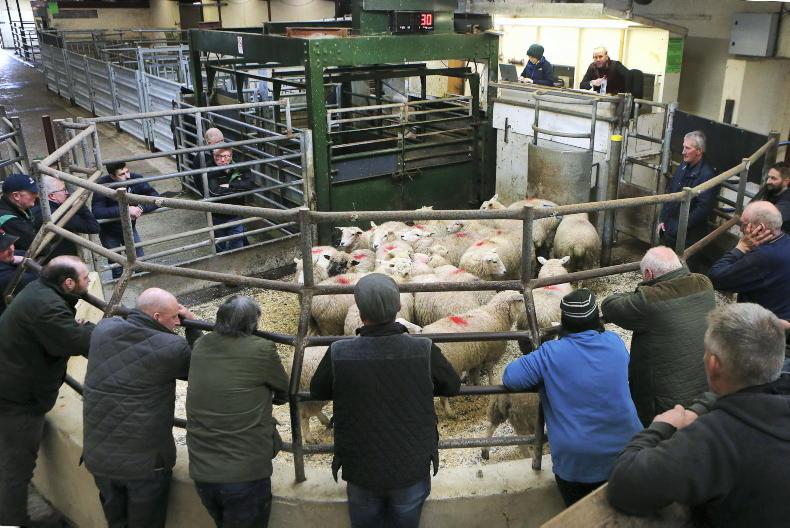Stable is the word best used to describe the deadweight beef trade in the early months of the year. However, there has been some downward movement in the trade in the last few weeks as supply and demand realign. Current base quotes for steers are in the region of €5.10/kg to €5.20/kg while base quotes for heifers are generally 5c/kg higher. Cattle kill forecasts for 2023 had indicated tighter cattle supplies in the first half of the year and this has been reflected in the weekly kill figures to date.
Up until the week ending 14 May 2023, the prime cattle kill in the Department of Agriculture-approved plants has totalled 641,000 head, a reduction of 31,000 head from the corresponding period in 2022.
Cattle supplies are expected to improve as we move into the second half of the year. However, some cattle may take longer to finish than anticipated. Extremely wet weather this spring and delayed grass growth in many parts of the country delayed turnout and impacted grazing plans on many farms. This may push out finishing dates and have an impact on average carcase weights.
The cow kill started the year very strongly with relatively good cull cow prices, rising input costs and nitrates banding all contributing to this trend.
The cow kill, however, has declined in recent weeks and the kill for the year to date is now running 4,000 head behind record 2022 levels.
Demand for beef has remained firm with tightening beef supplies in the EU helping to keep a floor under the market.
After a difficult year where consumers have been eating less and down trading on red meat consumption, there are now signs of some confidence returning and consumers planning to spend more on beef.
As we move into the summer months, demand for cheaper/forequarter beef cuts, including burgers, grills and value-added products, are expected to increase across our export markets in line with normal seasonal trends.
International
Bord Bia also continues to promote Irish beef on international markets, highlighted in recent weeks by promotional activities and events around the ministerial trade mission to China.
The first consignment of Irish beef to be exported to China in three years arrived in Shanghai in late April and the trade mission this month provided an excellent platform to further promote the sector.
A recent Bord Bia study shows 50% of Chinese consumers have indicated that they are eating more beef and this trend has been underlined by beef sales and import statistics in the market.
Consumers are eating beef because of the taste experience but in a market where health and nutrition is top of mind for the younger consumers with high spending power, beef has growing association with high-quality protein and health benefits.
Furthermore, they are recognising the role of naturally produced grass fed beef in this trend, which is good news for Irish beef as it re-establishes its position in the market.
The deadweight lamb trade had a difficult start to the year, however improved demand from key export markets in the run up to key religious festivals contributed to some increases in producer returns in March and April. The trade has further improved in the last few weeks with tighter supplies of suitable hoggets and spring lambs slow to come forward for processing. However, despite the improved trade the lamb market remains challenging with inflation continuing to have an impact on both retail and foodservice demand in the domestic and export markets. Profitability in the sector is also being further challenged and eroded by high input costs and the impact of the late spring on grass availability.
Hogget throughput year to date (YTD) has totalled 877,000 head, an increase of 42,000 head or 5% from year earlier levels. Lamb supply forecasts earlier in the year indicated an additional carryover of 50,000 to 60,000 lambs into 2023 to be processed as hoggets.
With a proportion of these still in the system they are expected to keep a floor under overall supplies for processing ahead of the 2023 lamb crop starting to appear.
Spring lamb supplies have been slow to start with throughput operating 26% behind 2022 levels.
Increasing production costs and declining producer confidence in the sector have also contributed to a 2% increase in cull ewe throughput this spring. Provisional forecasts have indicated a smaller lamb crop in 2023 with lower ewe numbers and poorer scanning results in some parts of the country contributing to this.
New Zealand and Australia continue to dominate the global sheepmeat market. There have been some positive indications that export demand for sheepmeat has stabilised with increased import demand in China, in particular, helping to absorb increasing volumes of sheepmeat from the global marketplace in recent months.
It is, however, worth noting that while volume demand in China has improved the prices available for individual products are notably lower than 2022 levels.
The deadweight lamb trade in both Australia and New Zealand are currently operating at lower levels than 2022 with a widening price differential with the European and UK markets making both markets very attractive to southern hemisphere exporters.
The outlook for the Irish lamb trade remains challenging this summer with Irish exporters potentially competing with increased volumes of UK lamb, as well as the more southern hemisphere product.
The UK has become increasingly export focused over the last 12 months with almost all the lamb they export destined for customers in the EU. The Agriculture and Horticulture Development Board (AHDB) has forecast a 15% increase in British lamb exports this year on the back of a higher hogget carryover, a stable lamb crop and weakening domestic demand.
The live export trade continues to provide an important option for Irish livestock farmers and traders.
For the year to date, total cattle export figures are operating 14% ahead of the same period last year despite some interruptions to the trade.
The Netherlands, Spain and Italy have continued to be the most important markets for Irish calves with smaller numbers also exported to other European markets.
After a relatively strong start to the year, the trading of older categories of cattle has been more subdued in recent weeks with a strong liveweight trade and tighter cattle supplies on the domestic market impacting the availability of cattle for export.
There have, however, been some indications of improving demand for Irish cattle in Northern Ireland with declining numbers of slaughter age cattle available in the region.
While the live export trade remains under intense scrutiny the short-term outlook remains fairly positive for all categories of cattle.
Tightening cattle numbers across Europe are expected to contribute to steady demand for Irish cattle during 2023 with very positive feedback from customers on the quality, health status and performance of Irish animals when they reach their destination.
Top European chefs visit suckler farms

Members of the UK chapter of the Chefs' Irish Beef Club on a visit in 2016
The Chefs’ Irish Beef Club (CIBC) is a network of renowned and Michelin star chefs from around the world who use and promote Irish beef.
The CIBC has eight chapters globally across France, the Netherlands, Belgium, Germany, Switzerland, Italy, Sweden and the United Arab Emirates (UAE), with 75 world-class head chefs serving as ambassadors of Irish beef.
This week (from 21 May), Bord Bia is hosting 16 members of the CIBC from Switzerland and Germany.
The chefs will visit suckler beef farms in the west of Ireland to experience the unique features of suckler beef production and the meat itself.
Any farmer who has joined the Suckler Carbon Efficiency Programme (SCEP), and is not yet a member of the Bord Bia Sustainable Beef and Lamb Assurance Scheme (SBLAS) must apply immediately to join.
New applicants can expect a period of up to three months from initially making contact with Bord Bia to final certification. However, if no non-compliances are found during the audit, this period will be shorter.
Steps to membership
Call 01 524 0410 to speak to the helpdesk. The helpdesk will assist you with your application and answer any queries about the SBLAS and the audit. You will receive a member pack, which contains:– A copy of the SBLAS Standard, ie the requirements of SBLAS.
– A pre-audit information checklist.
The Bord Bia farm book, containing templates to record all required records. Access details for the Farm Portal: farm.bordbia.ie.An auditor will contact you to choose a suitable time and date for your audit.
Stable is the word best used to describe the deadweight beef trade in the early months of the year. However, there has been some downward movement in the trade in the last few weeks as supply and demand realign. Current base quotes for steers are in the region of €5.10/kg to €5.20/kg while base quotes for heifers are generally 5c/kg higher. Cattle kill forecasts for 2023 had indicated tighter cattle supplies in the first half of the year and this has been reflected in the weekly kill figures to date.
Up until the week ending 14 May 2023, the prime cattle kill in the Department of Agriculture-approved plants has totalled 641,000 head, a reduction of 31,000 head from the corresponding period in 2022.
Cattle supplies are expected to improve as we move into the second half of the year. However, some cattle may take longer to finish than anticipated. Extremely wet weather this spring and delayed grass growth in many parts of the country delayed turnout and impacted grazing plans on many farms. This may push out finishing dates and have an impact on average carcase weights.
The cow kill started the year very strongly with relatively good cull cow prices, rising input costs and nitrates banding all contributing to this trend.
The cow kill, however, has declined in recent weeks and the kill for the year to date is now running 4,000 head behind record 2022 levels.
Demand for beef has remained firm with tightening beef supplies in the EU helping to keep a floor under the market.
After a difficult year where consumers have been eating less and down trading on red meat consumption, there are now signs of some confidence returning and consumers planning to spend more on beef.
As we move into the summer months, demand for cheaper/forequarter beef cuts, including burgers, grills and value-added products, are expected to increase across our export markets in line with normal seasonal trends.
International
Bord Bia also continues to promote Irish beef on international markets, highlighted in recent weeks by promotional activities and events around the ministerial trade mission to China.
The first consignment of Irish beef to be exported to China in three years arrived in Shanghai in late April and the trade mission this month provided an excellent platform to further promote the sector.
A recent Bord Bia study shows 50% of Chinese consumers have indicated that they are eating more beef and this trend has been underlined by beef sales and import statistics in the market.
Consumers are eating beef because of the taste experience but in a market where health and nutrition is top of mind for the younger consumers with high spending power, beef has growing association with high-quality protein and health benefits.
Furthermore, they are recognising the role of naturally produced grass fed beef in this trend, which is good news for Irish beef as it re-establishes its position in the market.
The deadweight lamb trade had a difficult start to the year, however improved demand from key export markets in the run up to key religious festivals contributed to some increases in producer returns in March and April. The trade has further improved in the last few weeks with tighter supplies of suitable hoggets and spring lambs slow to come forward for processing. However, despite the improved trade the lamb market remains challenging with inflation continuing to have an impact on both retail and foodservice demand in the domestic and export markets. Profitability in the sector is also being further challenged and eroded by high input costs and the impact of the late spring on grass availability.
Hogget throughput year to date (YTD) has totalled 877,000 head, an increase of 42,000 head or 5% from year earlier levels. Lamb supply forecasts earlier in the year indicated an additional carryover of 50,000 to 60,000 lambs into 2023 to be processed as hoggets.
With a proportion of these still in the system they are expected to keep a floor under overall supplies for processing ahead of the 2023 lamb crop starting to appear.
Spring lamb supplies have been slow to start with throughput operating 26% behind 2022 levels.
Increasing production costs and declining producer confidence in the sector have also contributed to a 2% increase in cull ewe throughput this spring. Provisional forecasts have indicated a smaller lamb crop in 2023 with lower ewe numbers and poorer scanning results in some parts of the country contributing to this.
New Zealand and Australia continue to dominate the global sheepmeat market. There have been some positive indications that export demand for sheepmeat has stabilised with increased import demand in China, in particular, helping to absorb increasing volumes of sheepmeat from the global marketplace in recent months.
It is, however, worth noting that while volume demand in China has improved the prices available for individual products are notably lower than 2022 levels.
The deadweight lamb trade in both Australia and New Zealand are currently operating at lower levels than 2022 with a widening price differential with the European and UK markets making both markets very attractive to southern hemisphere exporters.
The outlook for the Irish lamb trade remains challenging this summer with Irish exporters potentially competing with increased volumes of UK lamb, as well as the more southern hemisphere product.
The UK has become increasingly export focused over the last 12 months with almost all the lamb they export destined for customers in the EU. The Agriculture and Horticulture Development Board (AHDB) has forecast a 15% increase in British lamb exports this year on the back of a higher hogget carryover, a stable lamb crop and weakening domestic demand.
The live export trade continues to provide an important option for Irish livestock farmers and traders.
For the year to date, total cattle export figures are operating 14% ahead of the same period last year despite some interruptions to the trade.
The Netherlands, Spain and Italy have continued to be the most important markets for Irish calves with smaller numbers also exported to other European markets.
After a relatively strong start to the year, the trading of older categories of cattle has been more subdued in recent weeks with a strong liveweight trade and tighter cattle supplies on the domestic market impacting the availability of cattle for export.
There have, however, been some indications of improving demand for Irish cattle in Northern Ireland with declining numbers of slaughter age cattle available in the region.
While the live export trade remains under intense scrutiny the short-term outlook remains fairly positive for all categories of cattle.
Tightening cattle numbers across Europe are expected to contribute to steady demand for Irish cattle during 2023 with very positive feedback from customers on the quality, health status and performance of Irish animals when they reach their destination.
Top European chefs visit suckler farms

Members of the UK chapter of the Chefs' Irish Beef Club on a visit in 2016
The Chefs’ Irish Beef Club (CIBC) is a network of renowned and Michelin star chefs from around the world who use and promote Irish beef.
The CIBC has eight chapters globally across France, the Netherlands, Belgium, Germany, Switzerland, Italy, Sweden and the United Arab Emirates (UAE), with 75 world-class head chefs serving as ambassadors of Irish beef.
This week (from 21 May), Bord Bia is hosting 16 members of the CIBC from Switzerland and Germany.
The chefs will visit suckler beef farms in the west of Ireland to experience the unique features of suckler beef production and the meat itself.
Any farmer who has joined the Suckler Carbon Efficiency Programme (SCEP), and is not yet a member of the Bord Bia Sustainable Beef and Lamb Assurance Scheme (SBLAS) must apply immediately to join.
New applicants can expect a period of up to three months from initially making contact with Bord Bia to final certification. However, if no non-compliances are found during the audit, this period will be shorter.
Steps to membership
Call 01 524 0410 to speak to the helpdesk. The helpdesk will assist you with your application and answer any queries about the SBLAS and the audit. You will receive a member pack, which contains:– A copy of the SBLAS Standard, ie the requirements of SBLAS.
– A pre-audit information checklist.
The Bord Bia farm book, containing templates to record all required records. Access details for the Farm Portal: farm.bordbia.ie.An auditor will contact you to choose a suitable time and date for your audit.










SHARING OPTIONS